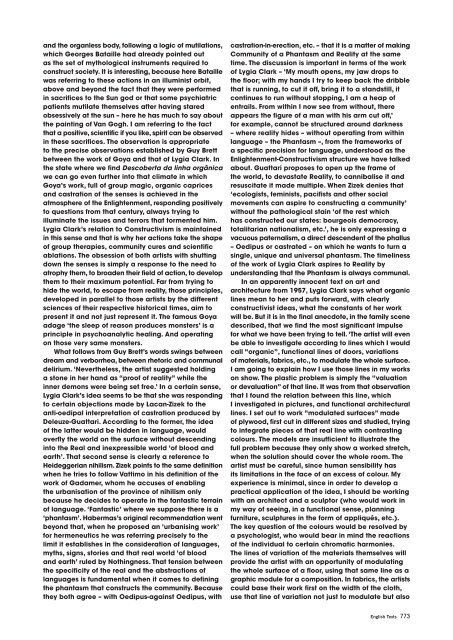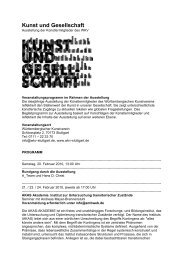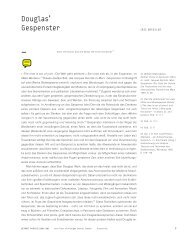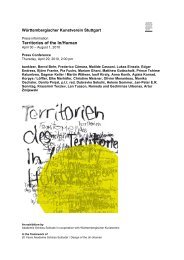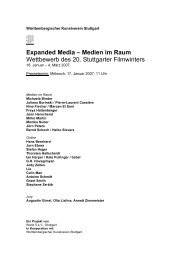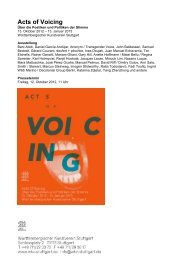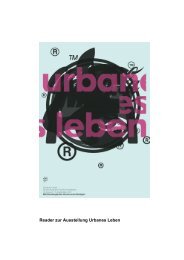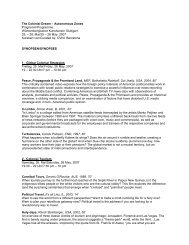English Texts
English Texts
English Texts
You also want an ePaper? Increase the reach of your titles
YUMPU automatically turns print PDFs into web optimized ePapers that Google loves.
and the organless body, following a logic of mutilations,<br />
which Georges Bataille had already pointed out<br />
as the set of mythological instruments required to<br />
construct society. It is interesting, because here Bataille<br />
was referring to these actions in an illuminist orbit,<br />
above and beyond the fact that they were performed<br />
in sacrifices to the Sun god or that some psychiatric<br />
patients mutilate themselves after having stared<br />
obsessively at the sun – here he has much to say about<br />
the painting of Van Gogh. I am referring to the fact<br />
that a positive, scientific if you like, spirit can be observed<br />
in these sacrifices. The observation is appropriate<br />
to the precise observations established by Guy Brett<br />
between the work of Goya and that of Lygia Clark. In<br />
the state where we find Descoberta da linha orgânica<br />
we can go even further into that climate in which<br />
Goya’s work, full of group magic, organic caprices<br />
and castration of the senses is achieved in the<br />
atmosphere of the Enlightenment, responding positively<br />
to questions from that century, always trying to<br />
illuminate the issues and terrors that tormented him.<br />
Lygia Clark’s relation to Constructivism is maintained<br />
in this sense and that is why her actions take the shape<br />
of group therapies, community cures and scientific<br />
ablations. The obsession of both artists with shutting<br />
down the senses is simply a response to the need to<br />
atrophy them, to broaden their field of action, to develop<br />
them to their maximum potential. Far from trying to<br />
hide the world, to escape from reality, those principles,<br />
developed in parallel to those artists by the different<br />
sciences of their respective historical times, aim to<br />
present it and not just represent it. The famous Goya<br />
adage ‘the sleep of reason produces monsters’ is a<br />
principle in psychoanalytic healing. And operating<br />
on those very same monsters.<br />
What follows from Guy Brett’s words swings between<br />
dream and verborrhea, between rhetoric and communal<br />
delirium. ‘Nevertheless, the artist suggested holding<br />
a stone in her hand as “proof of reality” while the<br />
inner demons were being set free.’ In a certain sense,<br />
Lygia Clark’s idea seems to be that she was responding<br />
to certain objections made by Lacan-Zizek to the<br />
anti-oedipal interpretation of castration produced by<br />
Deleuze-Guattari. According to the former, the idea<br />
of the latter would be hidden in language, would<br />
overfly the world on the surface without descending<br />
into the Real and inexpressible world ‘of blood and<br />
earth’. That second sense is clearly a reference to<br />
Heideggerian nihilism. Zizek points to the same definition<br />
when he tries to follow Vattimo in his definition of the<br />
work of Gadamer, whom he accuses of enabling<br />
the urbanisation of the province of nihilism only<br />
because he decides to operate in the fantastic terrain<br />
of language. ‘Fantastic’ where we suppose there is a<br />
‘phantasm’. Habermas’s original recommendation went<br />
beyond that, when he proposed an ‘urbanising work’<br />
for hermeneutics he was referring precisely to the<br />
limit it establishes in the consideration of languages,<br />
myths, signs, stories and that real world ‘of blood<br />
and earth’ ruled by Nothingness. That tension between<br />
the specificity of the real and the abstractions of<br />
languages is fundamental when it comes to defining<br />
the phantasm that constructs the community. Because<br />
they both agree – with Oedipus-against Oedipus, with<br />
castration-in-erection, etc. – that it is a matter of making<br />
Community of a Phantasm and Reality at the same<br />
time. The discussion is important in terms of the work<br />
of Lygia Clark – ‘My mouth opens, my jaw drops to<br />
the floor; with my hands I try to keep back the dribble<br />
that is running, to cut it off, bring it to a standstill, it<br />
continues to run without stopping, I am a heap of<br />
entrails. From within I now see from without, there<br />
appears the figure of a man with his arm cut off,’<br />
for example, cannot be structured around darkness<br />
– where reality hides – without operating from within<br />
language – the Phantasm –, from the frameworks of<br />
a specific precision for language, understood as the<br />
Enlightenment-Constructivism structure we have talked<br />
about. Guattari proposes to open up the frame of<br />
the world, to devastate Reality, to cannibalise it and<br />
resuscitate it made multiple. When Zizek denies that<br />
‘ecologists, feminists, pacifists and other social<br />
movements can aspire to constructing a community’<br />
without the pathological stain ‘of the rest which<br />
has constructed our states: bourgeois democracy,<br />
totalitarian nationalism, etc.’, he is only expressing a<br />
vacuous paternalism, a direct descendent of the phallus<br />
– Oedipus or castrated – on which he wants to turn a<br />
single, unique and universal phantasm. The timeliness<br />
of the work of Lygia Clark aspires to Reality by<br />
understanding that the Phantasm is always communal.<br />
In an apparently innocent text on art and<br />
architecture from 1957, Lygia Clark says what organic<br />
lines mean to her and puts forward, with clearly<br />
constructivist ideas, what the constants of her work<br />
will be. But it is in the final anecdote, in the family scene<br />
described, that we find the most significant impulse<br />
for what we have been trying to tell. ‘The artist will even<br />
be able to investigate according to lines which I would<br />
call “organic”, functional lines of doors, variations<br />
of materials, fabrics, etc., to modulate the whole surface.<br />
I am going to explain how I use those lines in my works<br />
on show. The plastic problem is simply the “valuation<br />
or devaluation” of that line. It was from that observation<br />
that I found the relation between this line, which<br />
I investigated in pictures, and functional architectural<br />
lines. I set out to work “modulated surfaces” made<br />
of plywood, first cut in different sizes and studied, trying<br />
to integrate pieces of that real line with contrasting<br />
colours. The models are insufficient to illustrate the<br />
full problem because they only show a worked stretch,<br />
when the solution should cover the whole room. The<br />
artist must be careful, since human sensibility has<br />
its limitations in the face of an excess of colour. My<br />
experience is minimal, since in order to develop a<br />
practical application of the idea, I should be working<br />
with an architect and a sculptor (who would work in<br />
my way of seeing, in a functional sense, planning<br />
furniture, sculptures in the form of appliqués, etc.).<br />
The key question of the colours would be resolved by<br />
a psychologist, who would bear in mind the reactions<br />
of the individual to certain chromatic harmonies.<br />
The lines of variation of the materials themselves will<br />
provide the artist with an opportunity of modulating<br />
the whole surface of a floor, using that same line as a<br />
graphic module for a composition. In fabrics, the artists<br />
could base their work first on the width of the cloth,<br />
use that line of variation not just to modulate but also<br />
<strong>English</strong> <strong>Texts</strong> 773


